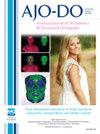Effects of curing lights on polymerization shrinkage of composite attachments in clear aligner treatment: A microcomputed tomography study
IF 2.7
2区 医学
Q1 DENTISTRY, ORAL SURGERY & MEDICINE
American Journal of Orthodontics and Dentofacial Orthopedics
Pub Date : 2025-01-01
DOI:10.1016/j.ajodo.2024.08.012
引用次数: 0
Abstract
Introduction
This study aimed to investigate the polymerization shrinkage of composite attachments and changes in attachment templates during bonding in clear aligner treatments.
Methods
A total of 24 extracted teeth were divided into 4 groups, and plaster models were digitized. Attachment templates were produced with beveled attachments on premolars and rectangular attachments on molars. Polymerizations used a halogen curing light (800 milliwatts per square centimeter [mW/cm2] for 20 seconds) and light-emitting diode (LED) curing light in 3 modes (1000 mW/cm2 for 20 seconds, 1000 mW/cm2 for 10 seconds, and 3200 mW/cm2 for 3 seconds). The curing distance was 5 mm, and temperature changes were recorded with a thermal camera. Microcomputed tomography scanning measured volumetric and linear attachments before and after polymerization. Statistical analyses employed a 1-way analysis of variance with Bonferroni corrected Tukey post-hoc for multiple comparisons and the Kruskal-Wallis test for temperature change.
Results
Significant differences (P <0.001) were found in temperature among curing lights. The highest temperature was in the LED unit-extra mode, and the lowest was in the halogen curing unit. The LED unit for 20 seconds caused the highest temperature change. A significant difference (P = 0.048) in occlusal attachment length was found between the LED unit for 20 seconds and the LED unit-extra mode. Polymerization resulted in increased attachment template thickness across all groups, with significant changes noted in the halogen unit, LED unit for 20 seconds, and LED unit-extra mode.
Conclusions
Temperature generated during polymerization varied between halogen and LED curing lights. Significant differences were found in attachment length at the occlusal level and template thickness postpolymerization. Preferences in attachment bonding protocols may affect the clinical precision of clear aligner treatments.
固化灯对透明矫治器治疗中复合附着体聚合收缩的影响:微计算机断层扫描研究。
简介:本研究旨在探讨透明矫治器治疗过程中复合附着体的聚合收缩和附着模板的变化:本研究旨在探讨透明矫治器治疗过程中复合附着体的聚合收缩和附着体模板的变化:方法: 将 24 颗拔牙分为 4 组,并对石膏模型进行数字化处理。制作的附着体模板前磨牙为斜面附着体,磨牙为矩形附着体。聚合时使用卤素固化灯(800 毫瓦/平方厘米 [mW/cm2] 20 秒)和发光二极管固化灯(1000 毫瓦/平方厘米 20 秒、1000 毫瓦/平方厘米 10 秒和 3200 毫瓦/平方厘米 3 秒)三种模式。固化距离为 5 毫米,用热像仪记录温度变化。显微计算机断层扫描测量了聚合前后的体积和线性附着情况。统计分析采用单因素方差分析,多重比较采用 Bonferroni 校正的 Tukey post-hoc 检验,温度变化采用 Kruskal-Wallis 检验:差异显著(P卤素灯和 LED 固化灯在聚合过程中产生的温度不同。在咬合水平的附着长度和聚合后的模板厚度方面存在显著差异。对附着粘接方案的偏好可能会影响透明矫治器治疗的临床精确度。
本文章由计算机程序翻译,如有差异,请以英文原文为准。
求助全文
约1分钟内获得全文
求助全文
来源期刊
CiteScore
4.80
自引率
13.30%
发文量
432
审稿时长
66 days
期刊介绍:
Published for more than 100 years, the American Journal of Orthodontics and Dentofacial Orthopedics remains the leading orthodontic resource. It is the official publication of the American Association of Orthodontists, its constituent societies, the American Board of Orthodontics, and the College of Diplomates of the American Board of Orthodontics. Each month its readers have access to original peer-reviewed articles that examine all phases of orthodontic treatment. Illustrated throughout, the publication includes tables, color photographs, and statistical data. Coverage includes successful diagnostic procedures, imaging techniques, bracket and archwire materials, extraction and impaction concerns, orthognathic surgery, TMJ disorders, removable appliances, and adult therapy.

 求助内容:
求助内容: 应助结果提醒方式:
应助结果提醒方式:


